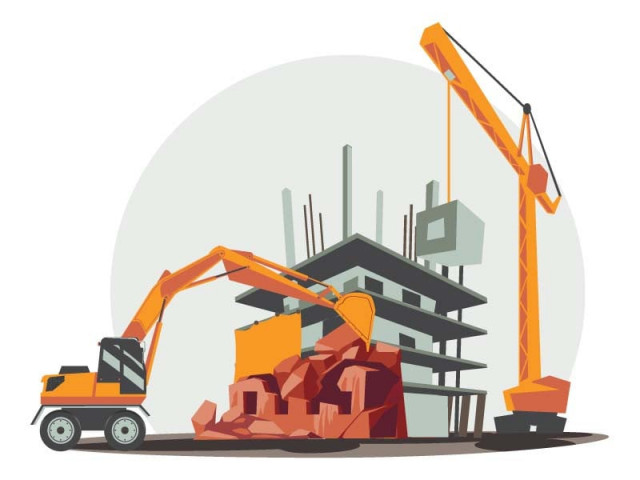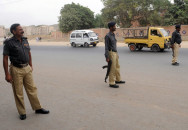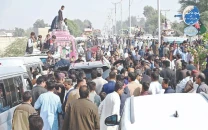Builders continue to prey on the city’s historic buildings
Owing to unchecked vertical development, Karachi has seen significant growth in urban issues

In the last couple of decades, Karachi, as a bustling metropolis, has been seen severe and uncontrolled vertical development fueled by the insatiable land-lust of the local builder mafias. Allegedly colluding with the provincial government, these outfits are responsible for drastically impacting the city’s urban landscape, constantly preying on historic structures and heritage sites to convert into high-rise buildings.
Per an independent survey conducted by The Express Tribune, so far hundreds of historic buildings in the old city area have been lost to unchecked vertical development, especially in places like Soldier Bazaar, Kharadar, Jamshed Road, MA Jinnah Road, Saddar, Clifton, and now Parsi Colony. As a consequence of this, the city has also seen significant growth of urban issues stemming from an added burden on the area’s resources. A patch of land that once accounted for 15 to 20 people, now houses 400 to 500 people in the form of vertically sprawling apartment buildings. “This has led to a rise in issues pertaining allocation of water, gas, electricity, parking space as well as issues with solid-waste management,” complained a resident of Soldier Bazaar, one of the city’s most severely affected areas. “If this keeps up, our city will soon lose all its historic architecture and there will be nothing to look back on,” he added.
In most cases, builder mafias that are well connected, tend to encourage owners of declared historic buildings to not repair their sites. Eventually, as the structure begins to wither, concerned authorities approve the demolition of the building on technical grounds, making it easier for the builders to acquire these sites. Another way to avoid legal issues is to keep the historic front portion or wall of the building intact and to demolish the structure inside and build commercial buildings there.
It is imperative to note that there are two categories of historic buildings: ones that are declared and others that are non-declared. While there are some 1,760 declared historic buildings in Karachi, there is no such list of non-declared historic buildings, making them more accessible preying builders.
However, as these mafias continue to sink their claws into the city, even the listed and declared historic buildings have become hard to keep safe. The Sindh Archives and Culture Department and the Sindh Building Control Authority, are two primary bodies responsible for preserving the declared historic buildings, but due to the negligence of these two institutions, many of the declared historic buildings have not only been demolished but converted into new buildings.
According to Muhammad Afzal, a resident of Soldier Bazaar, Preet Kutia, that once oversaw the entrance of Nishtar Park, was a declared historic building and stood there in full swing till 2020. “However, the owner of the building sold the site to builders who were keen on paying good money. When the demolition of the building started, the residents informed the concerned agencies and launched a massive campaign on social media but no action was taken. The building was finally demolished in a few days and now there is just an empty plot where the historic Preet Kautia once stood,” lamented Afzal.
Read More: ‘Roof gardens to revive historic buildings’
Muhammad Afzal, whose parents moved to Karachi ahead of 1947, resides within a property that dates back to pre-partition, and runs a small store in a historic building near the Clifton Bridge. “The new owners have now demolished the interior structure of the building that houses my shop, while maintaining the front portion. So now there is a new structure being constructed within the historic site by exploiting a legal loophole,” he informed.
Speaking on the matter, Saqib Shah, who oversees Heritage and Records of the Provincial Culture and Archives Department, told The Express Tribune that the Sindh Assembly had passed the 94 Sindh Cultural Heritage Preservation Act. “When the act was passed, the number of historic buildings declared was very small. A survey was conducted in 1997 in which a notification was issued for the historic building but it did not have the plot number which was taken advantage of by the owners and they continued to construct new buildings.
Shah says that the demolition of Preet Kutia in Soldier Bazaar took place before the 2018 survey of Karachi’s historic buildings. Regarding the demolition of historic buildings in Clifton, he said that with the approval of the Technical Committee and the Advisory Committee, the facade of these building has been maintained and a new building is being constructed inside to maintain the fusion of ancient and modern architecture.
Published in The Express Tribune, March 12th, 2022.



















COMMENTS
Comments are moderated and generally will be posted if they are on-topic and not abusive.
For more information, please see our Comments FAQ